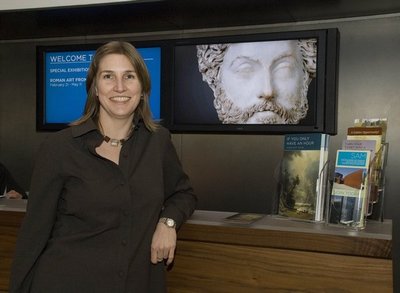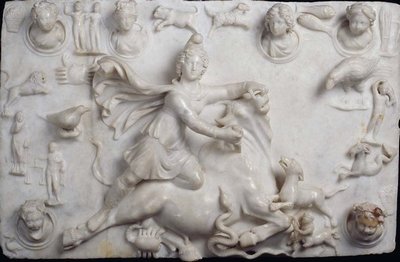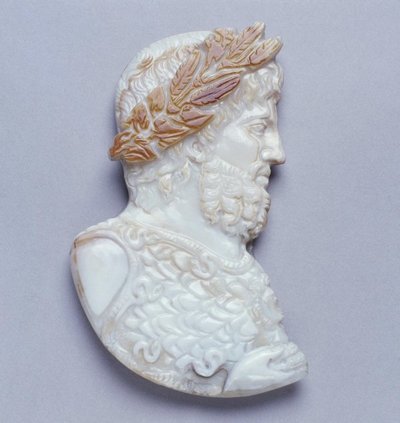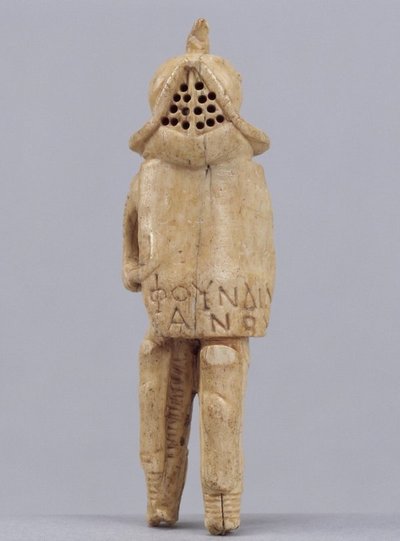February 14, 2008
It’s a ‘Roman holiday’ for UW prof
This academic year, Assistant Professor of Art History Margaret Laird has been spending a lot of time in Rome, and she’s taken some other UW professors and students with her. It isn’t the Rome in Italy she’s been visiting, however; it’s the Rome represented in Roman Art from the Louvre, an exhibit that opens Feb. 21 at the Seattle Art Museum.
Laird specializes in ancient Roman art history, and the museum, which doesn’t have a classical curator, has called upon her to be an adviser for its ancient art collection. A couple of years ago, museum officials told her they’d been approached about hosting the Roman art show during its tour in the United States, and asked her to evaluate it.
Laird’s evaluation was beyond positive, leading the museum to say yes to the exhibition and to ask her to serve as guest curator. “It’s a really fantastic exhibition,” she said. “At 184 pieces, it’s the largest traveling exhibition that the museum has ever done. It’s also probably the heaviest. Several pieces weigh 2,000 pounds or more. The heaviest one is 5,600 pounds. It’s going to take up the entire special exhibition space on the fourth floor.”
Roman Art from the Louvre looks at Roman society as created by its art and material culture. Objects are grouped by theme in different rooms. One gallery, for example, will be devoted to emperors and empresses, another to Roman citizens, another to soldiers, and so forth.
For Laird, being connected with the exhibit has been a special thrill — one that she wanted to share with colleagues and students. Shortly after taking on the guest curatorship, she had dinner with her friend Sandra Joshel, a history professor who studies slavery and work in ancient Rome, and the two began to talk about how they might take advantage of the exhibit’s presence. Soon, they had drawn in Classics Professor Alain Gowing, who studies Latin literature. The three put together a comprehensive curriculum for the year based on Roman art, history and literature, which includes classes at both the undergraduate and graduate levels.
Laird, for example, emphasized objects from the exhibition when she taught introduction to ancient art history in the fall. Joshel is currently teaching a class on the Roman Empire, while Gowing is teaching a class on Cicero and Ovid now and will teach a class on Roman satire in the spring. When she teaches a course on Roman sculpture in the spring, Laird plans to take her class to the exhibit several times.
She’s also gotten graduate students involved in the exhibition. She taught a seminar in the fall called Roman Art from the Louvre: Material Narratives of Culture and Society that included students from history, classics, art history and museology. Thanks to grants from the School of Art and the Classics Department, she was able to take the students to see the exhibit in Indianapolis, where the U.S. tour opened. The students then analyzed how the exhibition had been organized and read scholarly material on the objects included. Each student chose a subject to research and gave a talk on during the seminar. Based on their research, they presented proposals to the museum, and seven of them were chosen to give gallery talks during the exhibition. An additional three will put together podcasts that will be posted on SAM’s Web site.
Jason Shattuck, a history graduate student, will give a talk called Fear and Loathing in the Public Eye: Roman Men and Masculinity on Display. “The Romans,” he said, “would visually dissect anyone in public, examining him for the slightest defects of form, carriage, clothing, gesture or expression, and, based on these failings, attribute a wide variety of physical, mental and moral degeneracies to him.”
His talk will show how the stern, reserved look often seen in artistic representations of Romans reveals the insecurities they carried and the methods they used to assuage those fears.
Ashli Baker, a classics graduate student, is creating a podcast that is a dramatic reading of passages from the works of Augustus, Tacitus, Suetonius, Cassius Dio and Velleius Paterculus. “I felt strongly that the presence of at least a tiny portion of the literary tradition from the Roman Empire would enhance the visitor’s experience of the objects and I wanted to give voice to some of the more controversial traditions about the Julio-Claudians [the first five Roman emperors],” Baker said.
Both students were enthusiastic about the opportunity the seminar presented to learn about how an exhibition is developed and are looking forward to having their work available for the public. “It isn’t often that a classicist gets such a broad audience,” Baker said.
Shattuck agreed, saying that at best, most of his scholarly work will reach an audience numbering in the hundreds. “This is a great opportunity to break those bounds, to address another audience,” he said.
Laird is trying to reach the public in other ways, too. She and Joshel are currently teaching a Wednesday University class on Roman Art and Action. Sponsored by the Simpson Center, Seattle Arts and Lectures and the Henry Art Gallery, Wednesday University classes are offered to the general public for a fee.
And in April, Laird, Joshel and Gowing are organizing a free conference, Roman Imperial Art and Ritual. The conference has been funded by grants from the Simpson Center, the Seattle Art Museum, the departments of Classics and History, the Division of Art History, the Graduate School and the College of Arts and Sciences. The first evening, April 18, will be at the Seattle Art Museum, while the second day will be on campus. The conference is also open to anyone, although participants will need to reserve a space for the talk at the museum.
Laird will also be reaching out to high school teachers by offering a “Teachers as Scholars” class on the weekends before and after the conference. Titled The Art of Roman Religion, it is run through the Simpson Center. See <a href=http://depts.washington.edu/uwch/courses_teachers.htm>here</a>.
Laird thinks the exhibition will be a popular one, in the wake of recent entertainment such as the HBO series on Rome and the movie Gladiator. “People generally know something about Rome and can relate to the art,” she said.
For her, however, working on the exhibition has been a special treat. “If your research is on objects, you’re oftentimes working from facsimiles or slides or images from books,” she said. “Many of the objects in this exhibition are very, very famous and are in textbooks that I use. Having the opportunity to really live with them, to have them there in three dimensions as solid artifacts, it’s been thrilling.”
Roman Art from the Louvre will be at the Seattle Art Museum through May 11. For tickets, go to http://www.seattleartmuseum.org/. For information about the April conference, go <a href=http://depts.washington.edu/uwch/projects_roman0708.htm>here</a>.






